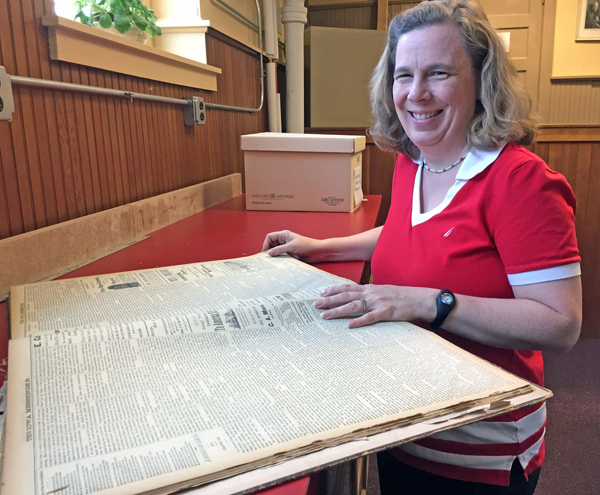
Assistant editor Anne Marie Amacher looks through an early 1900s copy of The Catholic Messenger in the archives at the Diocese of Davenport.
By Barb Arland-Fye
Editor
More than 100 volumes of old, hardbound copies of The Catholic Messenger reside in the basement of diocesan headquarters, some of them literally crumbling inside a glass-fronted bookcase. These newspapers date back to the mid-1880s, the early years of the Diocese of Davenport, when the printed page took center stage.
Fast-forward to 2019, when more and more printed pages are being digitized and stored in a “cloud” over the internet for posterity.
So it didn’t surprise me when the diocese’s new archivists sent an email asking if we could meet to talk about those old volumes of The Catholic Messenger. I knew the day of reckoning had arrived. Our newspaper’s board of directors has talked more than once about the fate of those hardbound issues, all of which have been digitally archived and also saved on microfilm.
Knowing that I love the printed page, our diocese’s two part-time archivists told me with as much empathy as possible, that something needs to be done with the deteriorating newspapers. The archivists need to free up space for the diocese’s other archival materials.
Before making a final decision, I asked to consult with an expert, historian Tim Walch, who serves on The Catholic Messenger Board of Directors. Wishfully, I hoped Tim would say, “You’ve got to keep those volumes because they are a physical, tangible part of the church’s history.”
But that is not what he said. Tim told me: “We face a dilemma in preserving our written heritage in general and newspapers in particular.
How can we best preserve the information and let go of the artifact? Put another way — how can we save the news but dispose of the paper? The answer is to microfilm and digitize these precious sources of history.”
“Unfortunately, it’s a bloodless solution. Many of us have a nostalgic bond to those broad sheets filled with information, curiosities and unusual photographs. Disposing of bound volumes of a newspaper is akin to a funeral for an old friend. It may be the right thing to do but it’s a sad day when the decision is made.”
Finally, I decided to “let go” of those issues that are in the worst condition, up to 1940. But first, I asked one of the archivists if I could go down to archives and page through some of the old volumes. Not a problem, she said. I spent a few hours wrapped up in another place and time: the lived experience of our church in 1884, 1885 and 1918.
Occasionally, I’d share out loud what I discovered on the printed pages.
All of these pages are preserved digitally, but it’s not the same. Physically turning a page feels like the unveiling of a surprise, the unwrapping of a gift of the printed word.
Sure, these literary gems are available in digital archives but I love the feel and scent of old newspapers. Reality sank in with each page I turned. Brown flakes of newsprint snowed all over me, the counter top and the floor. Some pages, surprisingly in the 1918 issue, ripped across the mid-section as I turned them.
While it’s time to say goodbye to the old volumes, Tim reminds me that we aren’t saying goodbye to the newspaper. “The Messenger and all diocesan newspapers are crucial for their role in preserving the longtime institutional memory of the diocesan Catholic Church. If we don’t have the written word of the Diocese of Davenport, how do we pass it on to the next generation?”
(Editor Barb Arland-Fye can be reached at arland-fye@davenportdiocese.org.)











